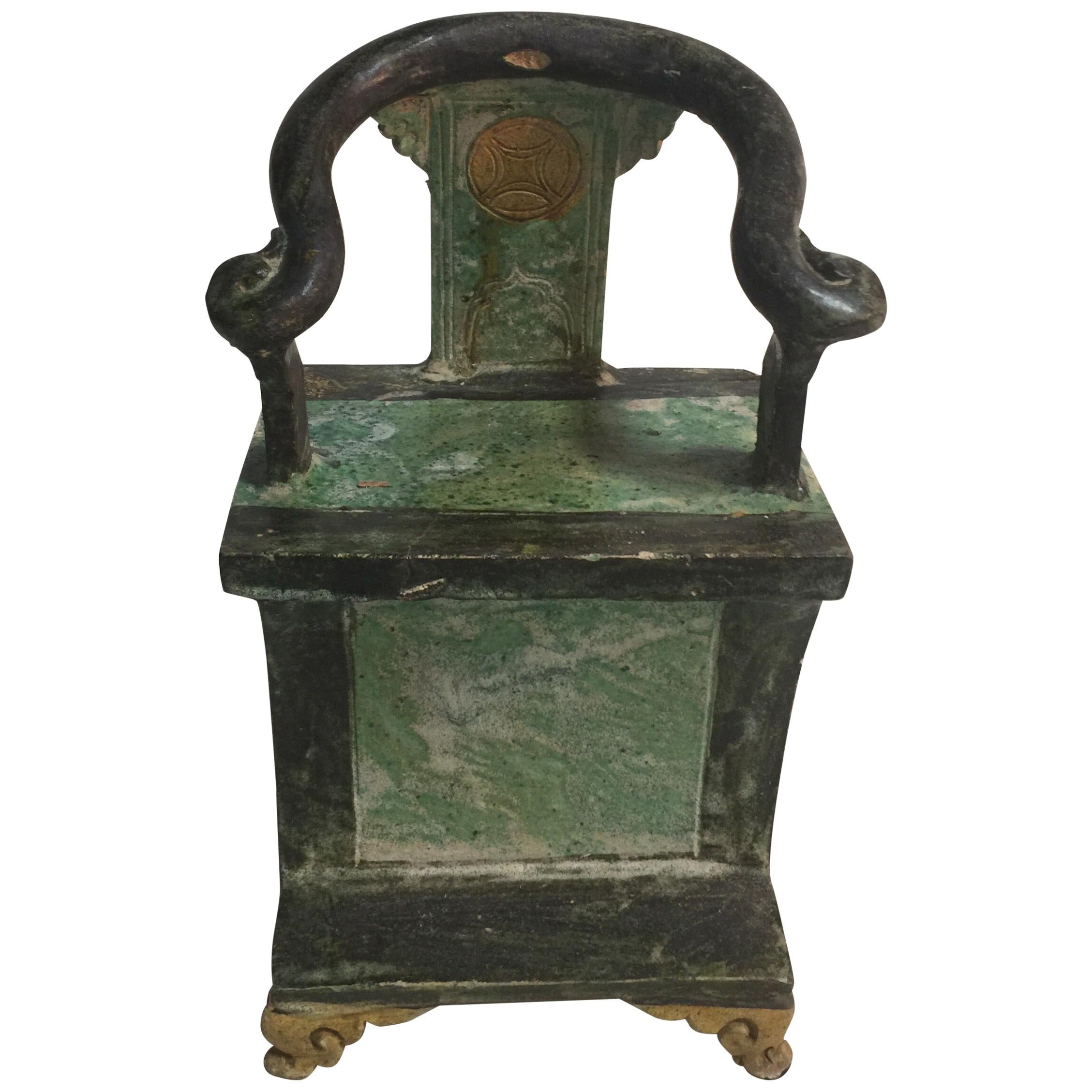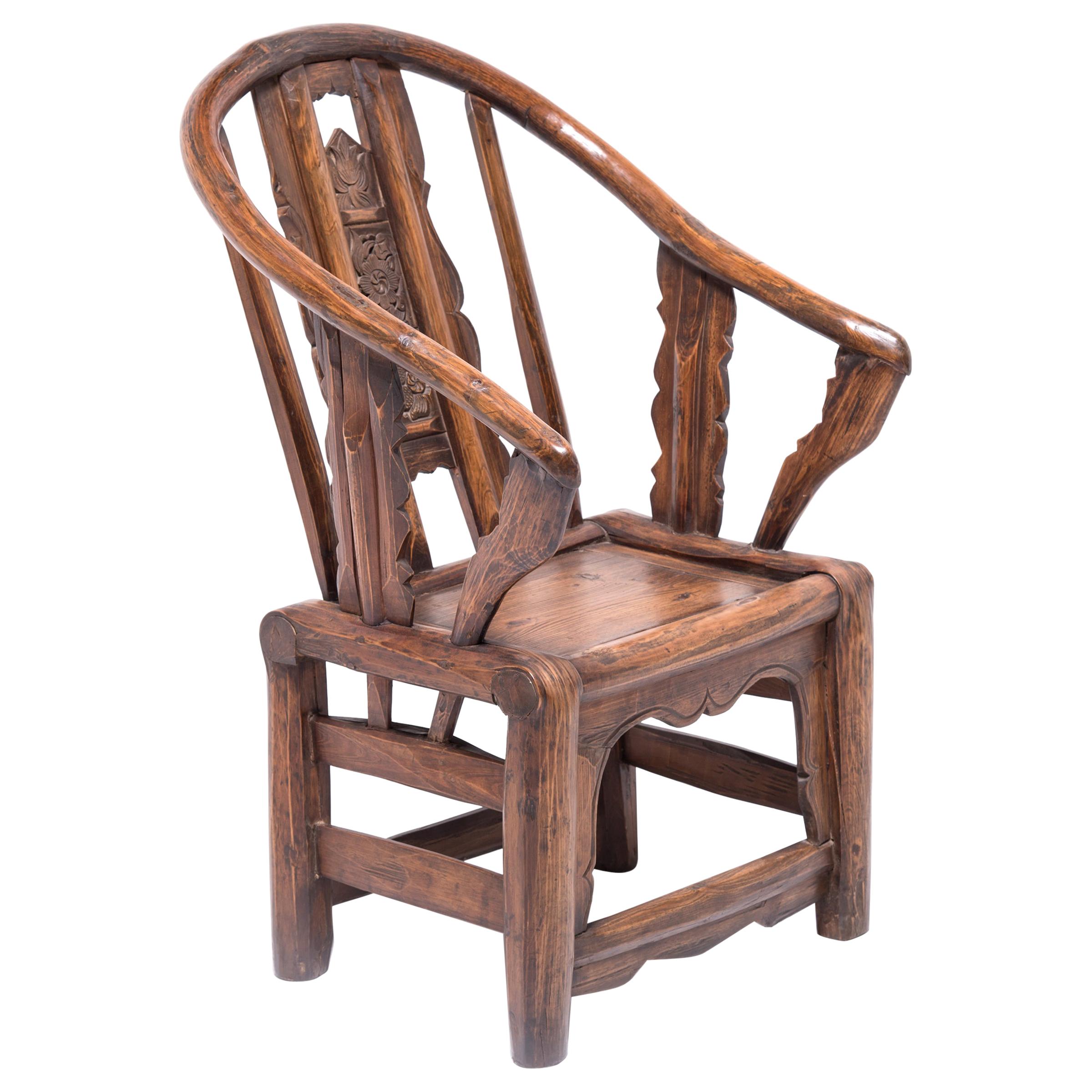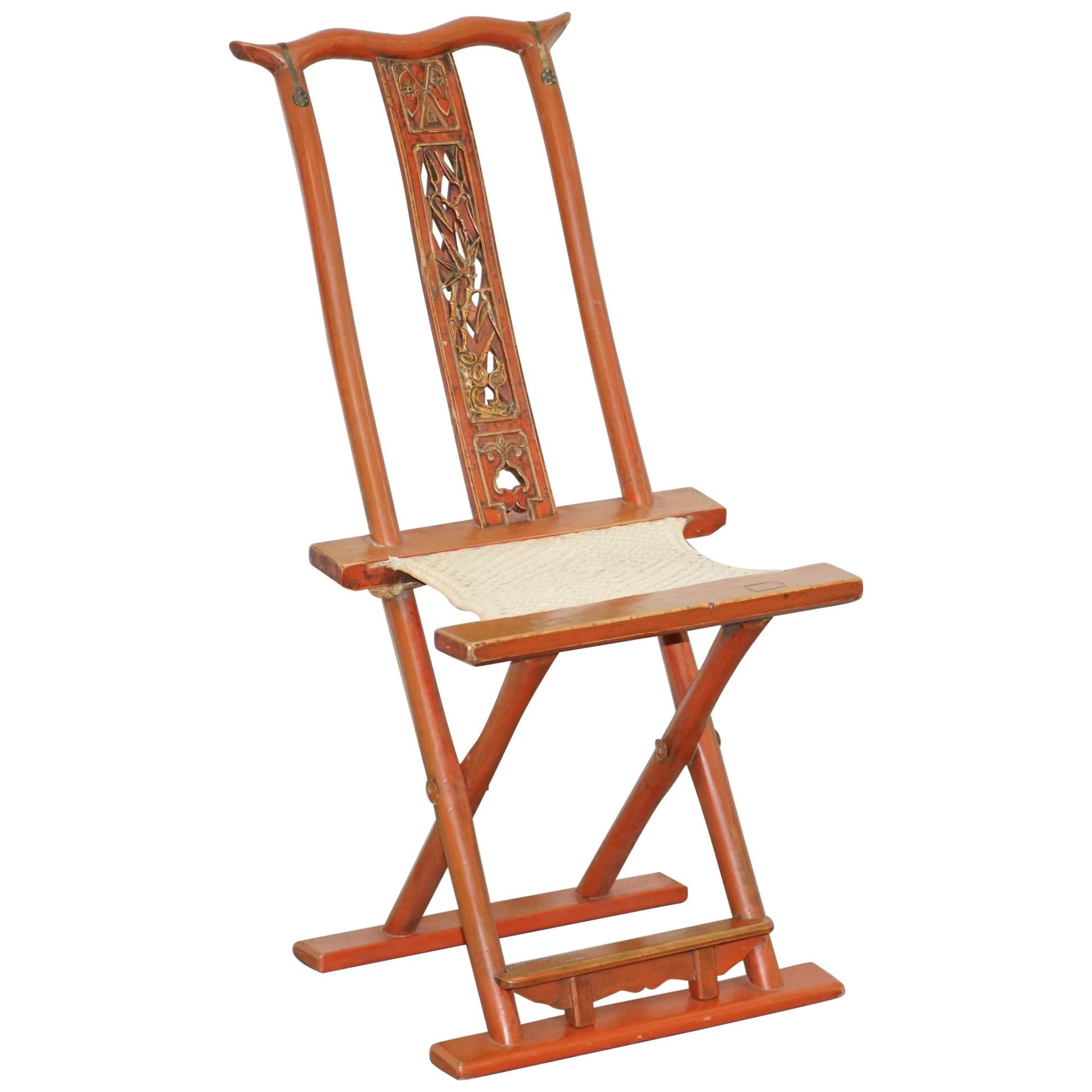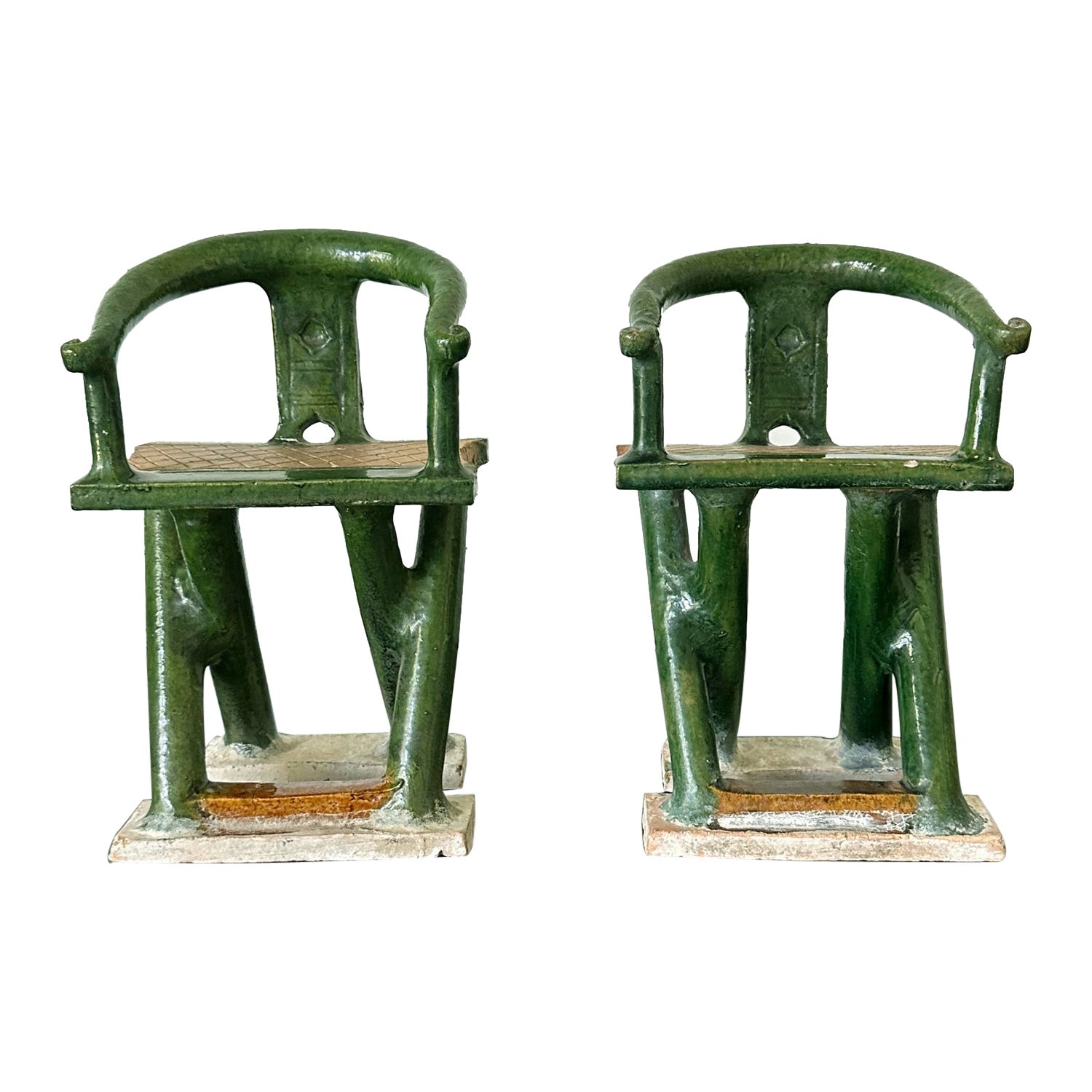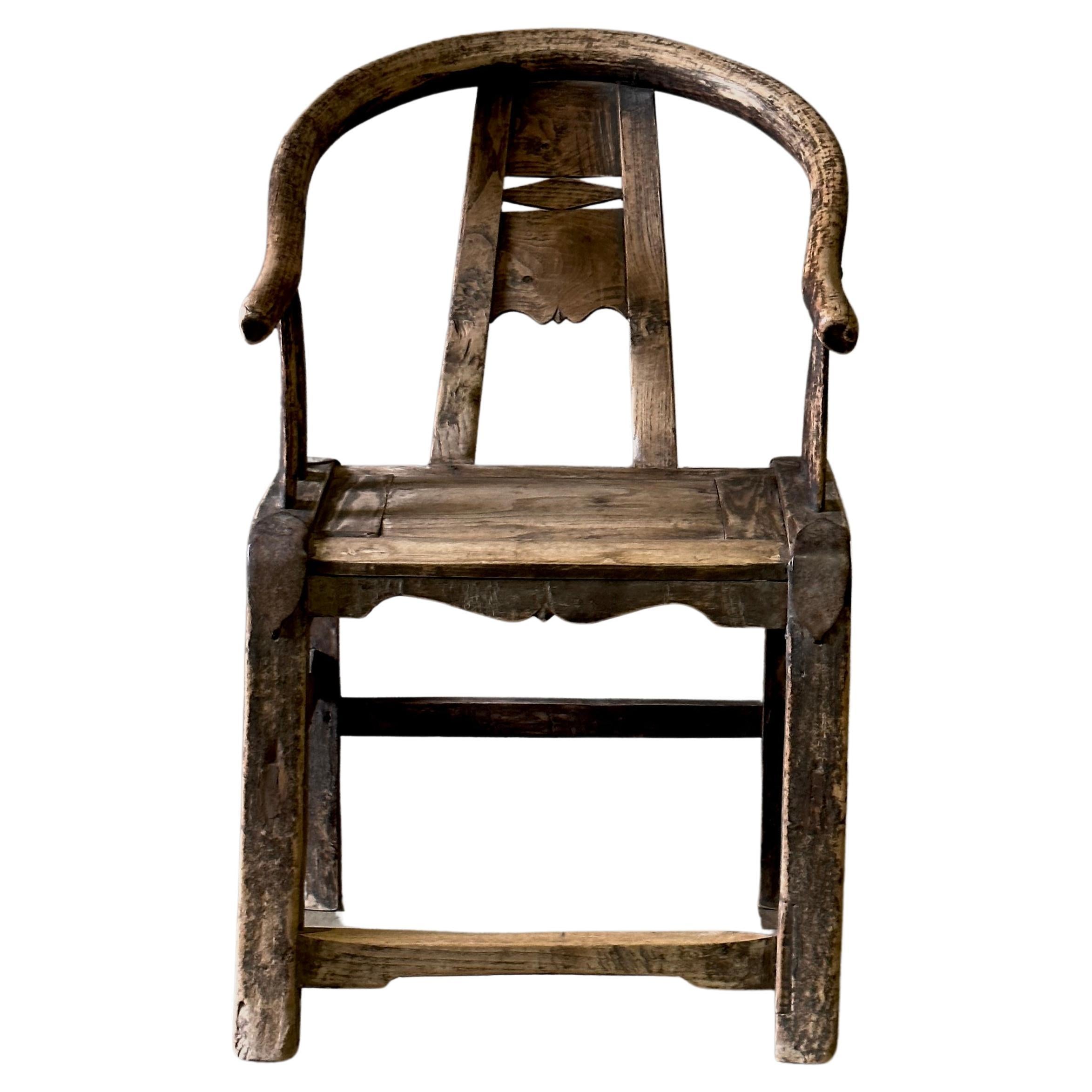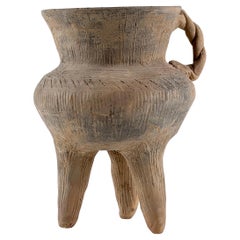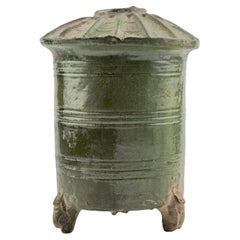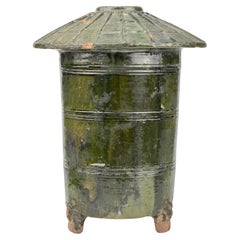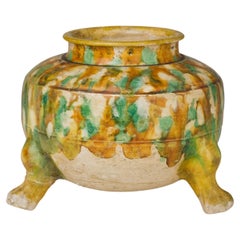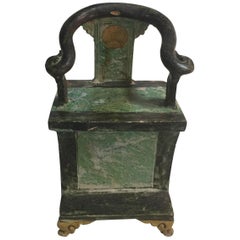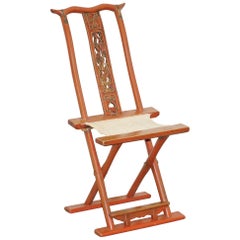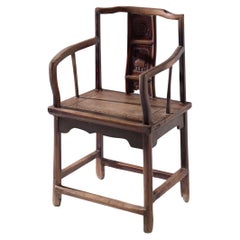Items Similar to 16th Century Pottery Model of a Folding Chair, Ming dynasty
Want more images or videos?
Request additional images or videos from the seller
1 of 11
16th Century Pottery Model of a Folding Chair, Ming dynasty
$903.50
$1,39035% Off
£685.92
£1,055.2635% Off
€784.55
€1,20735% Off
CA$1,262.32
CA$1,942.0335% Off
A$1,403.98
A$2,159.9635% Off
CHF 733.11
CHF 1,127.8735% Off
MX$17,084.89
MX$26,284.4535% Off
NOK 9,362.97
NOK 14,404.5635% Off
SEK 8,780.81
SEK 13,508.9435% Off
DKK 5,855.38
DKK 9,008.2835% Off
Shipping
Retrieving quote...The 1stDibs Promise:
Authenticity Guarantee,
Money-Back Guarantee,
24-Hour Cancellation
About the Item
This piece is an example of Mingqi, items specifically crafted for burial to accompany the deceased into the afterlife. The terracotta army is the most renowned example of such burial objects. Mingqi items represented people, houses, farms, granaries, livestock, and anything significant from this world to provide comfort and status in the next life. Unlike the life-sized and vast terracotta army, which reflected the importance of the first emperor of China, most Mingqi objects were small models, much smaller than the actual items or individuals they represented.
Period: Ming Dynasty (1368~1644)
Medium: Sancai-Glazed
Type: Mingqi
Provenance : Acquired in late 1990s from Hongkong
Reference:
1) Royal Ontario Museum - Object number: 918.10.3
(Type : Highly related)
2) British Museum - Museum number 1937,0716.135
(Type : Highly related)
* Ming dynasty Mingqi
The term Mingqi refers to the funerary objects specifically crafted for burial purposes during the Ming Dynasty in China. These objects were designed to accompany the deceased into the afterlife, providing comfort, status, and a semblance of the world they left behind. The word "Mingqi" translates to "spirit objects" or "vessels for ghosts."
Mingqi encompassed a wide variety of items, including models of people, animals, buildings, and everyday objects. These items were meticulously created to represent significant aspects of the deceased's life, such as their home, servants, livestock, and possessions. The purpose was to ensure that the deceased would have all the necessities and luxuries they enjoyed in life available to them in the afterlife.
The most famous example of Mingqi is the Terracotta Army, although it predates the Ming Dynasty, dating back to the Qin Dynasty. The Terracotta Army consists of life-sized statues of soldiers and horses buried with the first emperor of China, Qin Shi Huang. In contrast, most Mingqi objects from the Ming Dynasty were much smaller in scale.
Mingqi objects were typically made of pottery, wood, or metal, and while they varied in size and complexity, they were often crafted with great care and attention to detail. Some Mingqi items were functional and showed signs of wear, suggesting they were beloved possessions of the deceased. Others were purely symbolic, created solely for burial purposes.
The inclusion of Mingqi in tombs reflects the ancient Chinese belief in an afterlife where the dead would require the same comforts and status symbols as they did in life. This practice illustrates the importance placed on continuity between the earthly life and the afterlife, underscoring the cultural and spiritual values of the Ming Dynasty.
- Dimensions:Height: 7.88 in (20 cm)Diameter: 4.93 in (12.5 cm)
- Style:Ming (Of the Period)
- Materials and Techniques:Pottery,Glazed
- Place of Origin:
- Period:
- Date of Manufacture:16th Century
- Condition:Minor fading. Repairs on base and chair base.
- Seller Location:seoul, KR
- Reference Number:1stDibs: LU9577240292102
About the Seller
4.8
Gold Seller
Premium sellers maintaining a 4.3+ rating and 24-hour response times
Established in 1999
1stDibs seller since 2023
38 sales on 1stDibs
Typical response time: <1 hour
- ShippingRetrieving quote...Shipping from: seoul, Korea South
- Return Policy
Authenticity Guarantee
In the unlikely event there’s an issue with an item’s authenticity, contact us within 1 year for a full refund. DetailsMoney-Back Guarantee
If your item is not as described, is damaged in transit, or does not arrive, contact us within 7 days for a full refund. Details24-Hour Cancellation
You have a 24-hour grace period in which to reconsider your purchase, with no questions asked.Vetted Professional Sellers
Our world-class sellers must adhere to strict standards for service and quality, maintaining the integrity of our listings.Price-Match Guarantee
If you find that a seller listed the same item for a lower price elsewhere, we’ll match it.Trusted Global Delivery
Our best-in-class carrier network provides specialized shipping options worldwide, including custom delivery.More From This Seller
View AllPottery Tripod Vessel, Neolithic Period
Located in seoul, KR
The sturdy triangular legs, wide mouth, convex body, and diagonal incised patterns create a harmonious balance, showcasing a form that is both primitive and refined. Notably, the twi...
Category
Antique 15th Century and Earlier Hong Kong Antiquities
Materials
Earthenware, Pottery
$1,400 Sale Price
30% Off
Funerary Model of a Granary, Han dynasty
Located in seoul, KR
Cylindrical vessel on three animal-shaped feet (dragon or snake), wall with profile grooves, roof. pottery with green lead glaze. "Iridescence" is observed in surface.
Period : Han...
Category
Antique 15th Century and Earlier Hong Kong Han Antiquities
Materials
Pottery
$1,400 Sale Price
30% Off
Funerary Model of a Granary, Han dynasty
Located in seoul, KR
Cylindrical vessel on three animal-shaped feet (dragon or snake), wall with profile grooves, roof. Ceramic with green transparent glaze. "Iridescence" is observed in surface.
Period...
Category
Antique 15th Century and Earlier Hong Kong Han Antiquities
Materials
Stoneware
$2,242 Sale Price
25% Off
Sancai-Glazed Pottery Tripod Jar, Tang Dynasty
Located in seoul, KR
The globular body is supported on three claw feet and is covered in a splashed-glaze of amber, green and cream color, which stops short of the unglazed base.
Date : Tang Dynasty(61...
Category
Antique 15th Century and Earlier Hong Kong Tang Antiquities
Materials
Earthenware
$3,185 Sale Price
35% Off
Ming Period Large Pottery Horse with Saddle (15-16th Century)
Located in seoul, KR
This Ming Dynasty painted pottery horse is depicted standing on a tiered rectangular pedestal. The horse has a well-proportioned body, with sturdy legs and a slightly arched neck. The eyes and muzzle are subtly outlined and incised.
The mane is sculpted with deep, parallel grooves. The tail is long and slightly curved left, extending downward. The saddle is prominently featured at the center of the horse’s back, detailed with a raised, rounded seat and an attached stirrup hanging down one side. The saddlecloth is textured with a crosshatch pattern, bordered by a row of carved fringe-like elements. The horse's legs display subtle musculature, and the hooves are clearly defined, with black pigment accentuating their edges.
The original painted pigments, including white, black, and ochre, are still visible, though faded in some areas. The black pigment highlights the mane, tail, and parts of the bridle, while the ochre tones accentuate the saddle and decorative elements.
Period: Ming Dynasty
Medium: Green, black, and ochre glazed Pottery
Type: Figure
Provenance : Acquired in late 1990s from Hongkong
Reference : Asian Civilisations Museum - Accession No. C-1384 / 1994-00441 - Ming Dynasty Figure of Horse
(Type : Closely Related)
* Ming Dynasty Glazed Pottery Figures
Ming Dynasty glazed pottery figures are renowned for their bold color palette, intricate detailing, and lifelike forms, distinguishing them from earlier traditions. These figures, which depict officials, warriors, animals, and mythical creatures, are characterized by high-gloss lead-based glazes in green, amber, ochre, and sancai (three-color) combinations. The thickly applied glaze pools in recesses, creating depth and enhancing sculptural details. With dynamic postures, expressive facial features, and meticulously rendered drapery, these figures reflect the period’s advancement in ceramic craftsmanship, offering a greater sense of movement and realism compared to the rigid and stylized forms of earlier dynasties.
A defining characteristic of Ming glazed pottery is its elaborate surface detailing, often achieved through raised relief elements and contrasting glazes. Equestrian figures, for example, feature carefully sculpted saddles, harnesses, and decorative embellishments, while human figures are adorned with intricate robes and headdresses. The large scale of these tomb figures, often more imposing than those from previous periods, underscores the increasing importance of funerary art during the Ming era. Unlike later Qing Dynasty figures...
Category
Antique 15th Century and Earlier Hong Kong Ming Antiquities
Materials
Pottery
$2,600 Sale Price
35% Off
Ming Period Large Pottery Horse with Saddle (15-16th Century)
Located in seoul, KR
The figure stands on a rectangular base. The horse is depicted in a poised stance, with strong, muscular legs and a slightly bowed head. The mane is carefully sculpted with deep, flowing grooves, adding a dynamic texture to the piece. The head features expressive details, including a well-defined muzzle, flared nostrils. The bridle and harness are delicately painted in faded green, contrasting against the creamy beige body. The saddle is adorned with intricate details, including decorative tassels and a textured pattern, indicative of the elaborate tack used in the Ming period.
Traces of original polychrome pigments in green, black, and ochre remain on the surface, hinting at the sculpture’s once-vibrant appearance. The weathered patina and areas of flaking paint add to its historical authenticity, reflecting centuries of age. The overall craftsmanship and detailing exemplify the Ming Dynasty’s refined ceramic artistry, making this piece a remarkable representation of of asian culture during this period.
Period: Ming Dynasty
Medium: Green, black, and ochre glazed Pottery
Type: Figure
Condition : Good(chips on the upper saddle.)
Provenance : Acquired in late 1990s from Hongkong
Reference : Asian Civilisations Museum - Accession No. C-1384 / 1994-00441 - Ming Dynasty Figure of Horse
(Type : Closely Related)
* Ming Dynasty Glazed Pottery Figures
Ming Dynasty glazed pottery figures are renowned for their bold color palette, intricate detailing, and lifelike forms, distinguishing them from earlier traditions. These figures, which depict officials, warriors, animals, and mythical creatures, are characterized by high-gloss lead-based glazes in green, amber, ochre, and sancai (three-color) combinations. The thickly applied glaze pools in recesses, creating depth and enhancing sculptural details. With dynamic postures, expressive facial features, and meticulously rendered drapery, these figures reflect the period’s advancement in ceramic craftsmanship, offering a greater sense of movement and realism compared to the rigid and stylized forms of earlier dynasties.
A defining characteristic of Ming glazed pottery is its elaborate surface detailing, often achieved through raised relief elements and contrasting glazes. Equestrian figures, for example, feature carefully sculpted saddles, harnesses, and decorative embellishments, while human figures are adorned with intricate robes and headdresses. The large scale of these tomb figures, often more imposing than those from previous periods, underscores the increasing importance of funerary art during the Ming era. Unlike later Qing Dynasty figures...
Category
Antique 15th Century and Earlier Hong Kong Ming Antiquities
Materials
Pottery
$2,800 Sale Price
30% Off
You May Also Like
Antique Ming Dynasty Chinese Ceramic Ox Bow Tomb Chair from Gracie Gallery
Located in New York, NY
Antique Chinese green glazed ceramic votive chair.
Ming Dynasty 1368 A.D.–1644 A.D. Originally purchsed from Gracie Gallery, New York City; original label on base.
Provenance: A P...
Category
Antique Early 1600s Chinese Ming Ceramics
Materials
Ceramic
$990 Sale Price / set
89% Off
Low Chinese Bentwood Chair, c. 1850
Located in Chicago, IL
This bentwood chair was created over a century ago in northern China by moistening, bending, and heating willow to form its desired shape. It is beautifully carved with auspicious flowers and is considerably smaller than most roundback chairs. As the height and size of chairs were traditionally marks of status in Chinese culture, it is likely that this artful chair...
Category
Antique Mid-19th Century Chinese Qing Furniture
Materials
Elm
Antique Chinese circa 1900-1920 Export Folding Occasional Chair Nice Carvings
Located in West Sussex, Pulborough
Wimbledon-Furniture
Wimbledon-Furniture is delighted to offer for sale this lovely original Chinese red lacquered fret work carved folding chair with woven seat
Please note...
Category
Antique Early 1900s Chinese Chinese Export Furniture
Materials
Elm
$911 Sale Price
30% Off
Traditional Chinese Chair in Ming Style
Located in Milano, IT
This fascinating Chinese chair in Ming style, dating back to the 20th century and of Chinese craftsmanship, represents a fine example of traditional artistry, crafted from high-quality hardwood. The structure of the chair is a perfect example of elegance and refinement, typical of Chinese tradition, with simple yet harmonious lines that give it visual lightness and sobriety.
The backrest of the chair is particularly noteworthy for its refined carvings, adding an artistic and symbolic dimension. At the top of the backrest, the carving depicts a lotus flower, a symbol of purity and rebirth in Chinese culture. This floral motif has been skillfully carved, giving the chair a delicate and spiritual appearance.
At the bottom of the backrest, we find a traditional Chinese cauldron...
Category
Antique Early 1900s Chinese Ming Furniture
Materials
Wood
Pair of Chinese Ming Dynasty Tomb Funeral Pottery Chair Models
Located in Atlanta, GA
A pair of Chinese stoneware horseshoe cross chairs circa Ming dynasty (15th-17th century). The miniature models were traditionally made as burial offeri...
Category
Antique 16th Century Chinese Ming Ceramics
Materials
Stoneware
Rustic Chinese Carved Wood Chair
Located in Los Angeles, CA
This 19th-century Chinese accent chair is masterfully carved from wood, showcasing beautiful clean lines and a soft rustic patina. Its graceful and sculptural form makes it a captiva...
Category
Antique 1840s Chinese Furniture
Materials
Wood
More Ways To Browse
Wood 16th Century
16th Century Wood Furniture
British Art Pottery
Used Furniture Ontario
Chinese Ming Pottery
Ming Dynasty Glazed
Horse Pottery
Emperor Chair
Great Britain Chair
Century Furniture Ming Chair
Century Ming Chairs
Ming Dynasty Furniture 16th Century
Ming Dynasty Pottery
Chinese Ming Chairs
Chinese Soldier
Terracotta Horse
Sancai Glazed
Chinese Sancai
